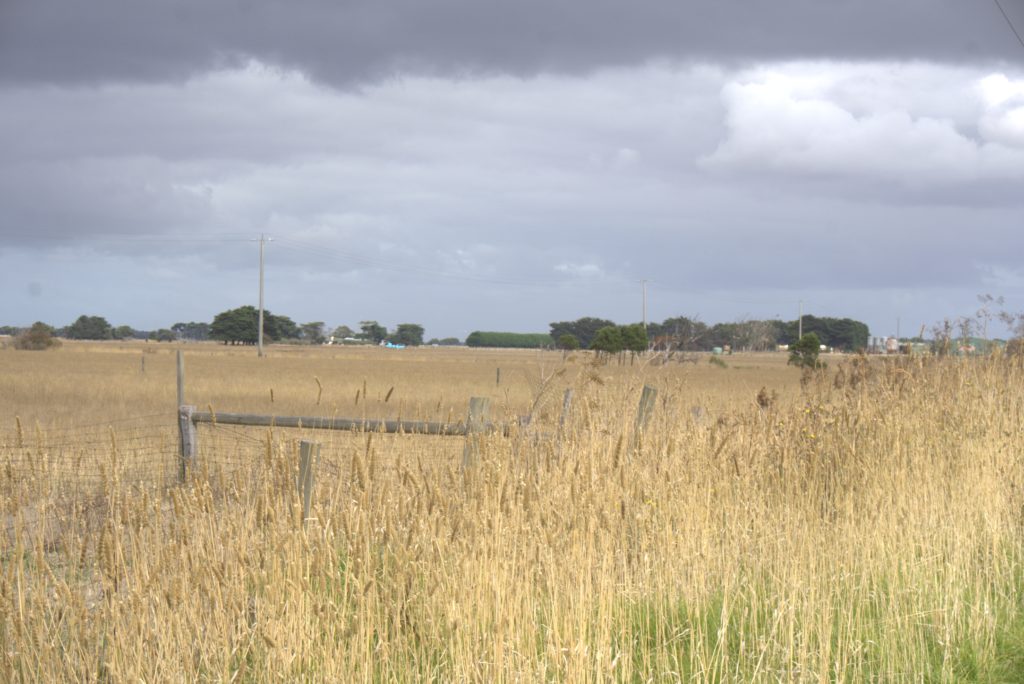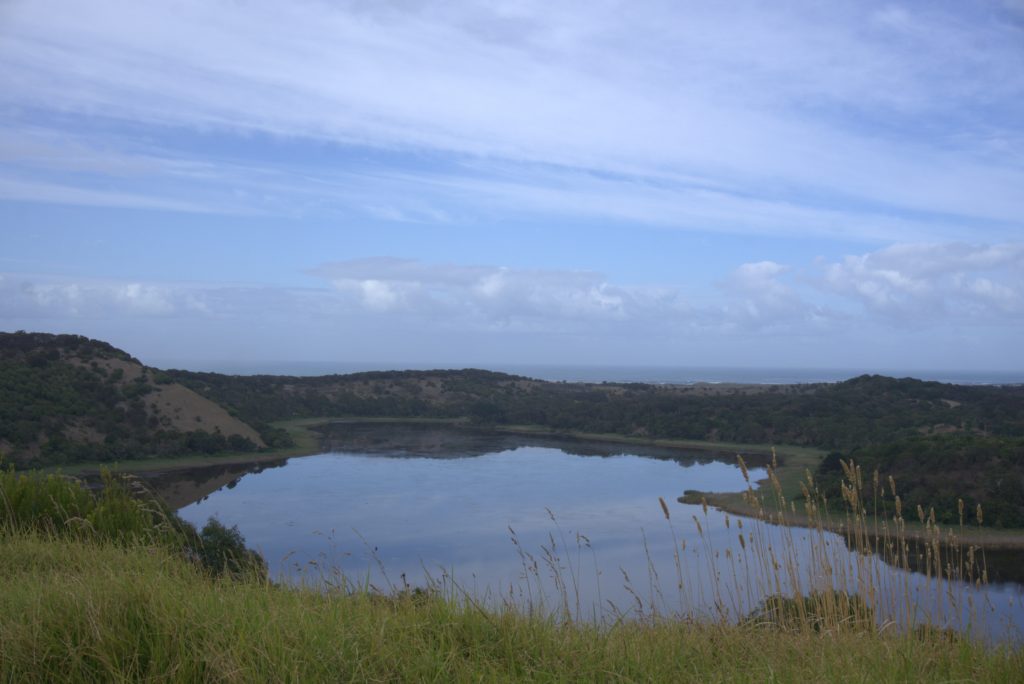The Baulch family name was unknown to us when we started our research but we quickly became aware of them through our Hallett family geneology. Maria Jane Baulch is the matrilineal great grandmother of Rhonnie Phillips and she was married to Samuel R Hallett of Belfast (Port Fairy), Victoria, Australia in 1890.

Maria was the daughter of Henry and Martha Baulch, who were cousins and the children of pioneer brothers who had arrived in Van Diemen’s Land (Tasmania) in 1842, as indentured farm servants. Our Baulch ancestors story starts here. The Baulch name simply means ‘a hardy person’ and in the 1850’s some 30% of people with that name resided in Somerset, England.
SOMERSET BEGINNINGS
Our Australian Baulch family history begins when three Baulch brothers, Francis, Charles and Enoch, who with their families emigrate to the Van Diemen’s Land Colony in 1842. These three brothers were the sons of Charles Baulch b1767 and Ann Biddlecombe b 1779, who married in 1799 at Muchelney, Somerset and lived in that district.
The family Baulch, in this district of Somerset, has a long history, but for our purposes Roger Baulch born around 1730 married Elizabeth Gaylord in 1756 at Muchelney and over the following 20 years the couple had ten children, three boys and seven girls. The boys were John b1757, Henry b1765 and Charles b1767. John died aged 17 years. Henry married Betty Harrod in October 1789 at Muchelney, Somerset. Charles is our family ancestor and we will examine his history in more detail.
Charles was born in 1767 at Muchelney and married Anne Biddlecombe of that village, in 1799. Charles’ brother Henry was a witness at their wedding. Anne b1779 was the daughter of Joseph Biddlecombe and Moriam Locke. Biddlecombe is a name that can be traced in the district back to the 1100’s. Joseph and Moriam had nine children before Joseph died in 1791.
Anne and Charles, who was a farm labourer throughout his life, had ten children, all born and baptised in Muchelney, except the youngest three, who were born at Pitney, an adjoining Somerset parish, where the family had moved in about 1812. The children were Grace b1801, George b1802, Francis b1804, Charles b1805, William b1808, Henry b1809, John b1811, Enoch b1814, Sarah b1815 and James b1821. Charles senior died around 1836. All his sons worked on the land as agricultural labourers from an early age. There were no schools, so none were educated and usually signed legal documents with a cross or ‘mark’. The land holders they worked for were often subsistence farmers with small lots of land, often leased, and using common land to graze live-stock. The early to mid-1800’s was the period during which, through acts of Parliament, the forced enclosure of common land occurred and a general absorption of land into the private ownership of the aristocratic class began. At the same time there was an economic depression following the War with France and there were repeated famines across the South-west of the country. All this driving many of those working on the land into poverty and a reliance on subsidies and handouts from the church or parish hierarchy.
THE BOUNTY SYSTEM
From 1839 to the mid 1840’s a ‘bounty’ system existed to get people from England and elsewhere to emigrate to the new colonies of NSW and Van Diemen’s Land. Settler land owners in the colonies were paid a government bounty or subsidy for every worker emigrant they arranged through shipping agents. The emigrant had to meet government stipulated need in the colonies and to meet other criteria, including being indentured to a land owner for a minimum of three years. The emigrant and their family paid the agent a smallish fee but otherwise travelled free. Importantly for our story the bounty scheme had been tightened to stipulate the skills required for applicants and by 1841, for Van Diemen’s Land, agricultural labourers or land servants, as they were called, aged under 40 years with family were in demand. The scheme was widely promoted in England by the agents especially in agricultural areas of high unemployment, such as Somerset, and at the time would have been heard about by Charles’ family. Charles had died in 1836, but by that time his children were adults, with the youngest son Enoch aged 22 (brothers John and James had died in 1830 and 1835) and the eldest son George, 34, and so it is necessary to look at their individual situations to understand the decisions being made by them in the early 1840’s and how the ‘bounty system’ was important.
DIFFERENT DECISIONS
No information has been identified in the records for Grace and George, the two eldest children, or Sarah, the youngest. Son William married Martha Cook b1813, at Pitney in 1832, where he was an agricultural labourer. In 1841 they had no children but mother Anne Baulch, who was 60 years, was living with them. William and Martha continued to live in Pitney until around 1845, when mother Ann Baulch married William Meade and moved out to live at High Ham, an adjoining hamlet. William and Martha, sometime around 1849 emigrated to America. In the 1850 New York State Census they are both shown working on adjoining farms, he as a farm labourer and she as a domestic servant, in Chatham, Columbia, New York State. There are no children identified for the couple in the US Census’ up to 1870. William continued as a farm labourer at Chatham to his retirement in 1870.
Son Henry married Priscilla Quantick in 1836 and they had ten children by 1861, mostly living at Underwood in the parish of Pitney, with Henry, like his brothers working as an agricultural labourer all his life. Henry died around 1875 and Priscilla 1892, living with son Joseph and his family at High Ham.
SOMERSET TO VAN DIEMEN’S LAND
The other three sons, brothers Francis, Charles and Enoch eventually decided on a more adventurous future. Brother Francis had married Ann Bowles b1816, who called herself Ann Edgar, due to her mother remarrying. Francis and Ann married in 1832 at Pitney, Somerset and lived there, where Francis was an agricultural labourer. They had six children by 1841 as shown on the census of that year. They were Elizabeth b1833, Mary Ann b1834, Sarah b1836, Henry b1837, James b1839 and George b1840.
Brother Charles married Jane Bartlett in 1831 also at Pitney, where he was an agricultural labourer, and they had a child George in 1837 but that had died shortly after and another child Mary Ann b1840.
Brother Enoch married Honor Meade in 1841, around June that year and they were also living in Pitney. Honor b1819 at High Ham was the daughter of William and Mary Meade. The same William Meade who became a widower and married Enoch’s mother, Anne Baulch, a widow, in 1845.
So, what decision did these three brothers make after this June census in 1841 that is of interest to us? Importantly, the three brothers, Francis, Charles and Enoch and their families set sail, together, for the new ‘southern’ colonies in December of that year 1841, aboard the ‘SS Arab’, arriving at Launceston on the 31st March 1842. Francis travelled with his family, wife Ann Edgar (Bowles) and 6 children. Charles travelled with his wife Jane Bartlett and one child, and Enoch with his pregnant wife Honor Meade, who had a child on route. All three men had signed up for the ‘bounty scheme’ and were assigned to the agent Henry Dowling Ltd, of Launceston as 1st Class ‘Farm Servants’, and cost him £40 for each of Charles and Enoch’s families and £68 for Francis’. All travellers, including the children and the new born, miraculously survived the journey.
VAN DIEMEN’S LAND SERVANTS
On arrival, Francis and Enoch commenced work for Thomas Fletcher at Lake River, Cressey, South of Launceston. They were registered as uneducated 1st Class farm servants, starting on a wage of £14 per annum plus rations, which increased to £30 after 3 years.
Brother Charles went to work for John Sinclair at Evandale, also as an uneducated 1st Class farm servant. Evandale is also south of Launceston and just East of Cressey. The brothers may have been able to keep in touch during the next nearly eight-year period to 1849, when Charles suddenly died at 44 years. Charles and Jane had had three more children at Evandale or Longford and they were Moses b1842, Jane b1844, but died that year, and Hannah b1845. Ann remarried in 1845 at Longford, one Richard Terry.
COLONY OF VICTORIA
After 10 years of farm labouring at Cressey and surrounds, around 1850/51, brothers Francis and Enoch Baulch and their families decided to make a ‘sea-change’ and travel to the new colony of Victoria.
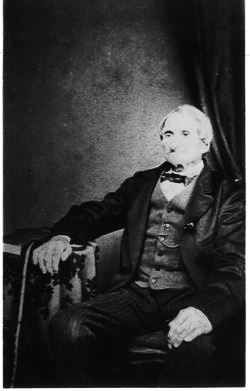
Francis and Ann left Tasmania aboard the ‘Sydney Griffith‘ that sailed from Hobart to Belfast (now Port Fairy) in 1851. They had with them the English born children, Sarah, Henry, James and George but not eldest daughters Elizabeth and Mary Ann, who had both married in Cressey. Also, Tasmanian born, William b1843, Samuel b1845, Susan b1847, John b1848 and Charles b1850. All these children were born at Longford, Tasmania.
They arrived at Belfast in late January 1851 and had to find some temporary lodgings, while Francis and the elder boys found work. In fact, it is on the record, that the family had to escape into the sea at Belfast, shortly after their arrival, to escape the Black Thursday bush fires of February that year.
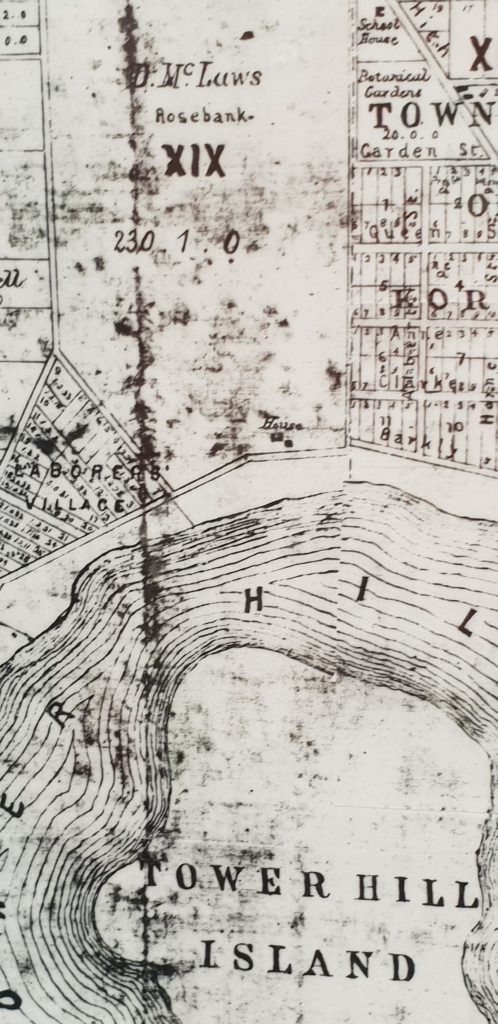
Immediately on arrival in the now colony of Victoria, Francis was off looking for farming or agricultural work and probably worked at several selections in the Port Fairy district before working his way to a new selection at Koroit, just North of Port Fairy, and adjacent to Tower Hill, which became known as ‘Rosebrooke’, where he is reported to have turned the first sods for the owner, one McLaws and continued to manage this land for a number of years.
This beautiful part of the new colony was just made for these experienced farmers who produced wheat and potatoes and other crops as well as sheep meat and wool to feed and clothe the rapidly growing population and for essential exports. Francis is believed to have arranged the first shipment of wool out of Port Fairy. Immediately below is a 2019 photograph of an 80 acre lot owned by Francis at Kirkstall and a view over the Tower Hill Lake, which has formed in a remnant volcano.
In and around Port Fairy and Koroit the couple had four more children and they were Alfred b1852, Enoch b1853, Harriet b1855 and Frederick b1857. This made a total of 15 children. Francis eventually bought land of his own at Kangaroo Flats, near Tower Hill and then another 80acres, in 1875, at Kirkstall and finally settled at that place.
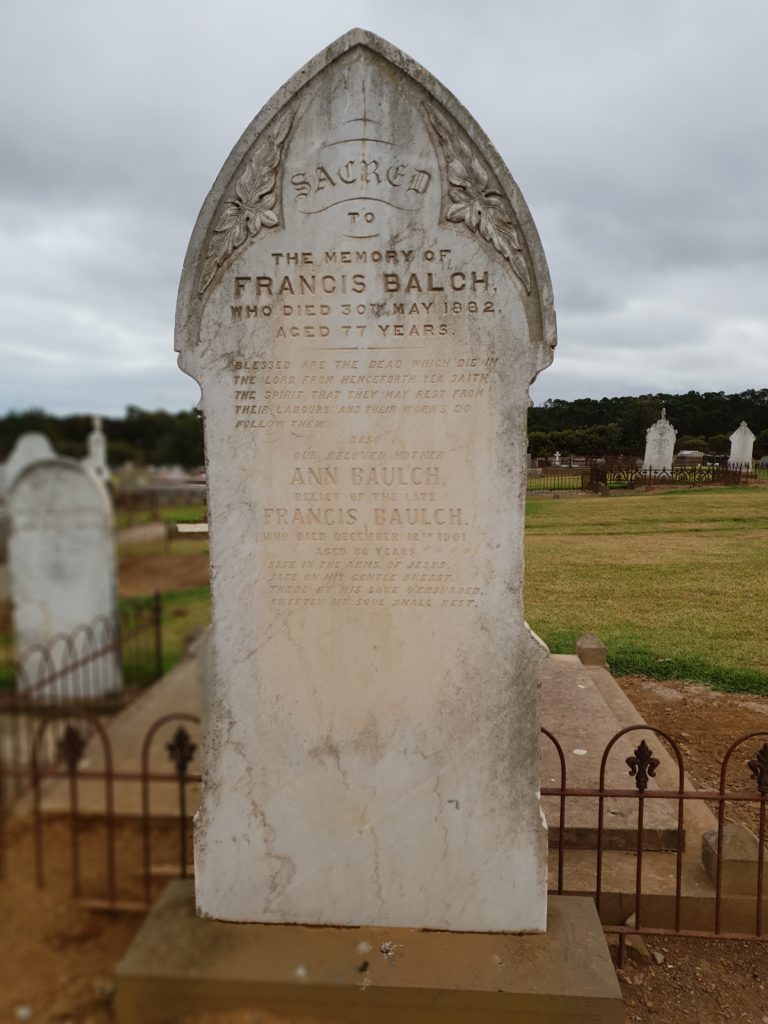
Francis died on the 30th May 1882 at Kirkstall and is buried at Tower Hill Cemetery. Ann died on Dec 12th, 1901 at Kirkstall and is buried at Tower Hill Cemetery with Francis.
Brother Enoch and his wife Honor left Tasmania sometime in 1852. They travelled with all their children, who were Mary Ann b1842, born aboard the ‘SS Arab’, Martha b1843, Lillian b1845, Joseph b1847, Ann b1848, Samuel b1849, and Charles b1851. After arriving in Victoria, we must assume that they immediately made their way to the Port Fairy district to link with Francis and the two brothers probably worked together in the district.
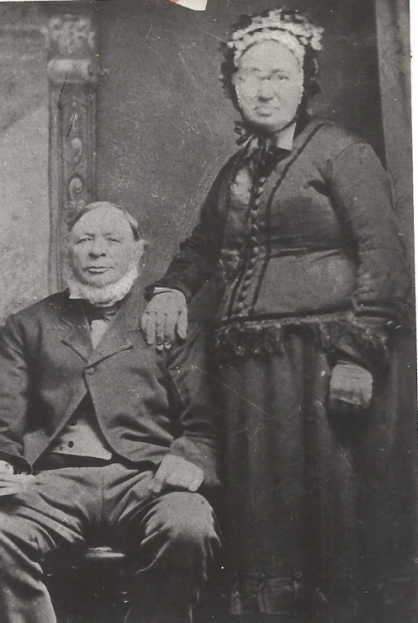
Certainly, the records show that Enoch and Honor had seven more children in and around Port Fairy and Kirkstall and they were Eva Mary May b1853, James b1855, Enoch b1856, George b1857, Silas b1859, Abijah b1860 and Salina b1867.
At some point in the late 1850’s the records show that Enoch bought 56 acres (Lot40) at the junction of Boundary and Kirkstall Road, just North of Koroit. He farmed this land into the 1870’s and then in 1876 advertised it for sale. In 1895 Enoch and Honor bought residential land in Belfast, running between James and Union Streets, where they retired for a short while.
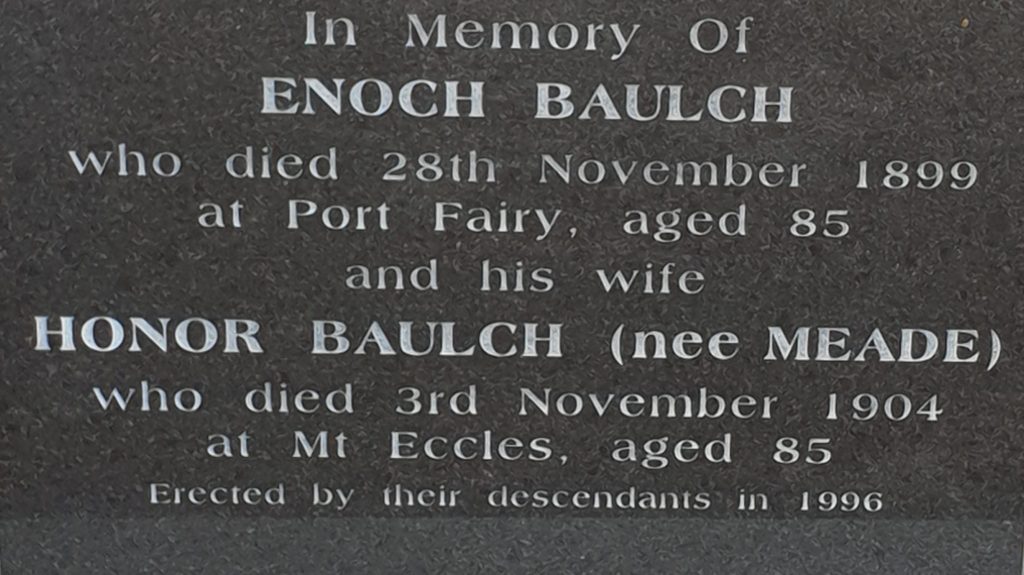
Enoch died 4 years later, in November 1899 and Honor in 1904, both at Mt Eccles, where they were probably living with one of their children. Both are buried at Tower Hill Cemetery.
These two Baulch families made a significant impression on the new colony of Victoria and in particular around the south-western district, centred on Port Fairy. There were 29 children across the two families to carry on the pioneering work started by Francis and Ann and Enoch and Honor. According to Cindy Baulch (Author of ‘The Story of Anne Baulch, nee Bowles‘), when Francis and Ann died, they left over 60 grand children and 20 great grand-children. If we assume that Enoch and Honor’s family were similar this is a major contribution and surely, with a history full of interesting stories. Certainly our South-Western Victorian Cousins have published some great stories and family trees. Visit Patsy”s Paddock and if you are in Victoria the Koroit Historical Society will answer all your questions. Thanks Cathy and Andrea.
One additional story worth telling here is about the exploits of Francis’ son Samuel Baulch b1845 at Longford, Tasmania. He arrived in Belfast with his father in early 1851. There were no schools, so it wasn’t long before Samuel had to start labouring on the land, probably around 1855, when he was 10 years old. Most of the surrounding area, as selected, was cleared for grazing cattle and sheep. Sheep became dominant as the price for wool grew. He would have worked with his father and brothers mostly moving through Tower Hill, Koroit and Kirkstall. They did mainly contract work such as clearing and fencing. At regular intervals around this time land selection opportunities arose, but you had to be able to afford the increasing land acre prices. Nevertheless by 1871 Samuel had selected for himself 316 acres at Hawksedale. He was increasingly successful with sheep wool growing and increased his holding to over 1500 acres (Rosepark) by 1880 plus other leased estates. In 1895, when Samuel was aged 50 years, he realised an earlier intent by purchasing at £16,000 the Dunmore estate of nearly 20,000 acres. The estate was run down, but Samuel made a success of it and became one of the shire’s leading landholders, a shire counsellor and a successful businessman. When Samuel died in 1919 the land was divided into three portions, which were allotted to his youngest sons. Samuel and both his wives are buried at Tower Hill Cemetery. There are still many Baulch’s in the Dunmore district.
HENRY AND MARTHA BAULCH
Time to go back to our family history connections. Both Francis and Ann and Enoch and Honor are our ancestors by virtue of two of their children marrying. Frances’ son Henry was born in Pitney in 1837, he was their fourth child and first son and he married Martha Baulch, Enoch’s eldest daughter, on 12th Jan 1863 in Port Fairy. Henry and Martha’s first child, Maria Jane, was born at Macarthur in 1865. Maria Jane is a direct ancestor and paternal great grandmother of Rhonda Phillips.
These were hard times but for some very hard. Henry and Martha had fourteen children born between Macarthur, Mt Eccles and Broadwater, 1865 to 1895. Of these, only 5 children survived more than two years and they were Maria Jane, Eliza, Eva, Ada and Minerva. Of those who didn’t survive – four died at birth, unnamed; Francis, Robert, John, Bessy and Stephen all died before 15months. Of the survivors, Eliza also died at 14 years. In short out of fourteen children only four girls survived to adulthood. One of those was our ancestor Maria Jane.
We know nothing of Maria’s child hood. There may have been schooling as she was certainly able to write when she was an adult. Interestingly, Maria, before she married Samuel Robert Hallett, had signed the 1891 Women’s Suffrage Petition, whilst at Yangery, a small hamlet close to Tower Hill. An interest in things political.
